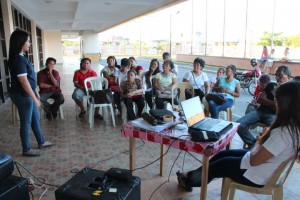 After the barangay assembly, chosen volunteers from Brgy. Bitano, Legazpi City were oriented about Kalahi-CIDSS last April 18, 2013 at the Ibalong Centrum for Recreation. Donna Osial [left], a DSWD staff, discusses their roles and responsibilities as volunteers in the project.
After the barangay assembly, chosen volunteers from Brgy. Bitano, Legazpi City were oriented about Kalahi-CIDSS last April 18, 2013 at the Ibalong Centrum for Recreation. Donna Osial [left], a DSWD staff, discusses their roles and responsibilities as volunteers in the project.
From the coverage of rural barangays, Kalahi-CIDSS has now expanded to the urban setting with its pilot implementation in Legazpi City wherein residents of Bitano and Rawis attended the first barangay assembly (BA) for the Kapit-Bisig Laban sa Kahirapan-Comprehensive and Integrated Delivery of Social Services (Kalahi-CIDSS) project.
The BA was conducted in Bitano and Rawis last April 19 and 20, respectively. The staff from the Department of Social Welfare and Development (DSWD) oriented the crowd about different aspect of Kalahi-CIDSS project.
World Bank (WB) has granted P1 million each for Bitano and Rawis as part of the pilot implementation of urban Kalahi-CIDSS in Luzon. It started last January and will end March 2014.
What is Kalahi-CIDSS?
Kalahi-CIDSS is one of the poverty reduction programs implemented by the Department of Social Welfare and Development (DSWD). It stands for Kapit-Bisig Laban sa Kahirapan-Comprehensive and Integrated Delivery of Social Services.
Employing “Community-Driven Development” as a primary strategy, Kalahi-CIDSS trains communities together with their local governments (barangay and municipal) to choose, design, and implement development projects to address their most pressing needs. Through the Project, communities and local government units have built school buildings, farm to market roads and bridges, health stations, day care centers, post-harvest facilities, and implemented capacity building and projects that address poverty needs.
On the other hand, the first set of volunteers was elected wherein there were two representatives for each purok. Through this, CDD is operationalized by involving the residents in the decision-making process of the government.
Alfonso Bantigui, Jr. of Zone 4, Bitano, was one of the chosen community volunteers who will study their local situation and conduct a community research.
He is one of those who will identify the key problems in their community that causes poverty, and identify the range of possible solutions to address these problems.
“Magayon po na naghahale sa tawo su consultation ta kaipuhan talaga hapotun ang tao dahil dakol ang saindang mga pangangaipo. Sa paagi ning Kalahi-CIDSS, nahihiling man na may magayon pa na programa ang gobyerno [It’s better that the people is consulted because they what are their needs. Through Kalahi-CIDSS, it is seen that government has good programs for the people],” he said.
Barangay Assembly Defined
As defined in the Local Government Code, R.A. 7160, BA is a gathering of barangay residents who are Filipino, at least 15 years old and above, and listed in the records as members of the barangay assembly. It is conducted at least twice a year.
In Kalahi-CIDSS, community consultations are done through BAs by providing updates and feedbacks to the people about the project and are conducted with a minimum of five (5) BAs in a cycle (year).
Other groups of volunteers formed during the course of Kalahi-CIDSS implementation include the Barangay Representation Teams (BRT), Project Preparation Teams (PPT), Community-Based Monitoring Team (CBMT) and Barangay Sub-Project Management Committees (BSPMCs). All volunteers are elected during BAs. ###jmarbella
